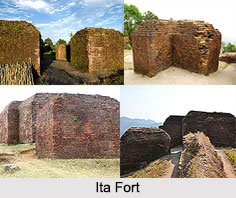 Ita Fort at Itanagar was built in the 14th or the 15th century by kings of the Chutia Dynasty. It is said that the city of Itanagar in Arunachal Pradesh got its name from the fort itself. Archaeological finds from the site are on display at the Jawaharlal Nehru Museum, Itanagar. Ita Fort means the fort of bricks. The fort was built with bricks with an irregular shape. Total brickwork is 16,200 cubic meter long. Ita Fort has three different entrances located at three different sides- western, eastern and southern sides.
Ita Fort at Itanagar was built in the 14th or the 15th century by kings of the Chutia Dynasty. It is said that the city of Itanagar in Arunachal Pradesh got its name from the fort itself. Archaeological finds from the site are on display at the Jawaharlal Nehru Museum, Itanagar. Ita Fort means the fort of bricks. The fort was built with bricks with an irregular shape. Total brickwork is 16,200 cubic meter long. Ita Fort has three different entrances located at three different sides- western, eastern and southern sides.
Etymology of Ita Fort
The name Ita Fort literally means "fort of bricks", as bricks are being called "Ita" in the Assamese language. It also lends its name to the city Itanagar, the capital of Arunachal Pradesh.
History of Ita Fort
Ita Fort is thought to be one of the early forts which the great Chutia King Ratnadhwajpal initially built all around his kingdom from Biswanath till Disang. According to the historians, the Ita Fort was built by the Chutia King Ramachandra Pratap Narayan who had his capital in Ratanpur, Majuli. It is also mentioned that Ramachandra Pratap Narayan was the grandson of king Mayurdhwaj. In the genealogy of the Chutia kings, Mayurdhwaj is believed to have ruled the middle of the 14th century. According to the Nyishi tribal folklore, one of the kings from the plains was charmed by the beauty of a Nyishi woman who then married her and built the Ita Fort as a palace for the new queen.
Structure of Ita Fort
The Ita Fort has an irregular shape, built mainly with bricks dating back to the 14th-15th Century. The fort is enclosed by natural ridges and brick ramparts. There are two brick walls and three gates; the brick ramparts can be seen in the western and eastern sides. There is more than half a kilometer long rampart in the eastern side with just one gate. The western rampart is more than 1.40 km in length and has two gates. In the north and south sides of the fort, irregular steep ridges of more than a kilometer length can also be witnessed. The bricks of the fort are typically of medieval and pre-Ahom period.
Visiting Information on Ita Fort
Ita Fort can be visited all around the year. Naharlagun Railway Station and Lilabari Airport are the nearest to visit the fort. After reaching Itanagar, one has to take a vehicle to reach the fort. Indira Gandhi Park is located 2 km away from the fort, which can also be visited.



















